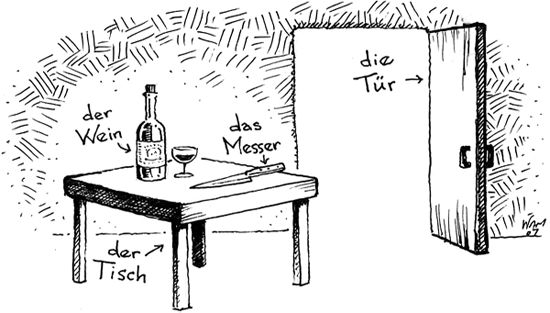1.5.1.1: Nouns gender
- Page ID
- 104723
Nouns: Genus der Substantive
In a rare bow to logic, German noun genders actually make sense when they match the biological gender of the noun.
| der Vater (the father) | die Mutter (the mother) |
| der Sohn (the son) | die Tochter (the daughter) |
Other times the genders are pretty randomly assigned. Only one thing is for sure: every German noun has a grammatical gender, which you should learn just like you learn the plural form (because there is no real logic to either one!). The genders are indicated with an article preceding the noun: der for masculine, die for feminine and das for neuter nouns.

| Masculine |
| der Tisch (the table) |
| der Bach (the creek) |
| der Wein (the wine) |
| Feminine |
| die Tür (the door) |
| die Blume (the flower) |
| die Brille (the eyeglasses, in German this is a singular noun!) |
| Neuter |
| das Messer (the knife) |
| das Nachthemd (the nightgown) |
| das Käppchen (the cap) |
Although you do have to memorize noun genders, there are some other hints that can help you remember if a noun is der, die or das. Check this out:
If the noun ends in -er, -en, -ig, -ling, -us, -mus, -or, chances are it's masculine.
(der Jäger, der Materialismus)
If the noun ends in -in, -ion, -ung, -heit, -keit, -schaft, -ei, -ur, -ik, -tät, -anz, -enz, -ie, it's feminine.
(die Prinzessin, die Nation, die Gesundheit)
If the noun ends in -tum, -chen, -lein, -ment, -um (-erl, -le, -el, -li = dialect variants), it's neuter.
(das Königtum, das Medikament)
And sometimes Germans themselves can't agree on the noun gender! This can happen when new words are borrowed from other languages and adopted into German, like the word for yogurt: some Germans call it das Joghurt (northern Germany) and der Joghurt (southern Germany)


